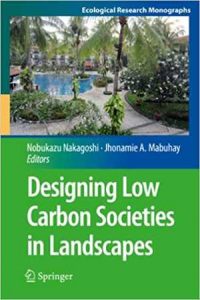نام کتاب: Designing Low Carbon Societies In Landscapes
نویسنده: Nobukazu Nakagoshi و Jhonamie A. Mabuhay
ویرایش: ۱
سال انتشار: ۲۰۱۴
کد ISBN کتاب: ۹۷۸۴۴۳۱۵۴۸۱۸۸, ۹۷۸۴۴۳۱۵۴۸۱۹۵
فرمت: PDF
تعداد صفحه: ۳۵۳
انتشارات: Springer Japan
Description About Book Designing Low Carbon Societies In Landscapes From Amazon
This book focuses on three major means of achieving a low carbon society: conservation of the ecosystem complex, changes of arrangement of landscapes, and creation of biodiversity. There are specific countermeasures to be taken for carbon absorption in the three types of landscapes—urban, cultural, and natural—because their carbon balances differ. Urban landscapes are promising sites because they have the potential for greening and the creation of biodiversity. Cultural landscapes in the tropics had not been actively researched until recently, but this book now presents a collection of several cases focused on those areas. Natural landscapes had existed in abundance in developing countries; later, nature protection areas were designated to coexist with development. Now, however, developmental pressure has penetrated into those nature protection areas, and landscape ecological projects are urgently required to preserve them.
As a result of global warming, abnormal weather phenomena including super typhoons have occurred frequently in recent years. The major underlying cause is the higher concentration of greenhouse gases released by human activities. As well, major natural absorbers of CO2 such as forests, wetlands, and coral reefs are shrinking, and the human impact is causing the ecological balance to deteriorate. Controlling CO2 emissions and expanding the CO2 absorbers are keys to reducing total CO2. Low carbon societies can be established by maintaining the original CO2 balance through integration of multiple tools, with contributions from diverse fields such as physics and chemistry, physiology and humanities, and education. On the basis of an international consensus, the environment must be protected no matter what sacrifices are required. As this book demonstrates, achieving a low carbon society is a top priority, and landscape conservation is the first step in ecological research toward that goal.
درباره کتاب Designing Low Carbon Societies In Landscapes ترجمه شده از گوگل
این کتاب با تمرکز بر سه ابزار اصلی برای دستیابی به یک جامعه کم کربن: حفاظت از پیچیده اکوسیستم، تغییر آرایش از مناظر، و ایجاد تنوع زیستی است. هستند اقدامات متقابل خاص برای جذب کربن در سه نوع از مناظر شهری، فرهنگی و طبیعی به دلیل توازن کربن خود را متفاوت گرفته شود وجود دارد. مناظر شهری سایت های وعده زیرا آنها دارای پتانسیل برای سبز و ایجاد تنوع زیستی است. مناظر فرهنگی در مناطق استوایی شده بود به طور فعال تا همین اواخر تحقیق نیست، اما این کتاب در حال حاضر ارائه مجموعه ای از چند مورد در آن مناطق متمرکز شده است. چشم انداز های طبیعی که به وفور در کشورهای در حال توسعه وجود داشته است؛ بعد، مناطق حفاظت از طبیعت به همزیستی با توسعه شدند. اما در حال حاضر، فشار توسعه است به آن مناطق حفاظت از طبیعت نفوذ، و پروژه های زیست محیطی چشم انداز به فوریت مورد نیاز به آنها را حفظ کند.
به عنوان یک نتیجه از گرم شدن کره زمین، پدیده غیر طبیعی آب و هوا از جمله توفان فوق العاده اغلب در سال های اخیر رخ داده است. علت عمده اساسی غلظت های بالاتر از گازهای گلخانه ای منتشر شده توسط فعالیت های انسانی است. همانطور که به خوبی، جذب و بزرگ طبیعی از CO2 مانند جنگل، تالاب ها، و صخره های مرجانی در حال کم شدن و تاثیر انسان است که باعث تعادل زیست محیطی به وخامت گذاشته است. کنترل انتشار گاز CO2 و گسترش جذب CO2 کلید به کاهش CO2 ها هستند. جوامع کم کربن را می توان با حفظ تعادل CO2 اصلی را از طریق ادغام ابزار های متعدد، با کمک از زمینه های مختلف مانند فیزیک و شیمی، فیزیولوژی و علوم انسانی، و آموزش و پرورش است. بر اساس اجماع بین المللی، محیط زیست باید حفظ شود بدون توجه به آنچه فداکاری مورد نیاز است. از آنجا که این کتاب نشان می دهد، دستیابی به یک جامعه کم کربن یک اولویت بالا است، و حفاظت از چشم انداز اولین گام در تحقیقات زیست محیطی به سمت آن هدف است.
[box type=”info”]![]() جهت دسترسی به توضیحات این کتاب در Amazon اینجا کلیک کنید.
جهت دسترسی به توضیحات این کتاب در Amazon اینجا کلیک کنید.![]() در صورت خراب بودن لینک کتاب، در قسمت نظرات همین مطلب گزارش دهید.
در صورت خراب بودن لینک کتاب، در قسمت نظرات همین مطلب گزارش دهید.

